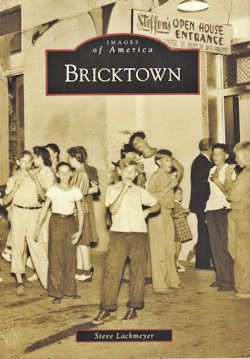 This article reviews Images of America: Bricktown by Steve Lackmeyer (Arcadia Publishing 2009) and is long overdue.
This article reviews Images of America: Bricktown by Steve Lackmeyer (Arcadia Publishing 2009) and is long overdue.The book became available in January 2009 and Steve's 1st book-signing occurred at Full Circle Books on January 20. I'd planned to go but the couch upon which I was then sleeping most comfortably apparently had a greater hold on my priorities that night.
I did make the next book-signing at Bricktown's Red Dirt Emporium on February 12 — great because I got to see a pair of videos about Neal Horton and Bricktown that evening. You can see those videos at Steve & Jack Moneys' OKC History Blog. You can purchase Bricktown at any local bookstore or on-line at Amazon.com.
Baker's Dozen Slide Show Book Contents & Description
4-Page Introduction Photographs My Opinion
BAKER'S DOZEN SLIDE SHOW. Before getting into detail, here's a brief slide show presenting what I've called "A Baker's Dozen" of the book's images. Steve said that I could use 12 images from the book for this review. I'm not counting the Bricktown map as one of the 12 since I made it! But, 13 other images are also presented but, hey, who is to say that 13 is NOT 12 ... 13 is a baker's dozen, and I hope that he doesn't mind my method of counting!
BOOK CONTENT. The book is organized as shown by the following Table of Contents ... I've added a few content comments:
THE BOOK'S FULL INTRODUCTION. Given Arcadia's approach to books in its Images of America series, a book's Introduction gives an author the greatest opportunity to present information in a scholarly way. Steve has allowed that I present each of those 4 pages for you to read — if you can't read the small print, click on an image for a larger view.

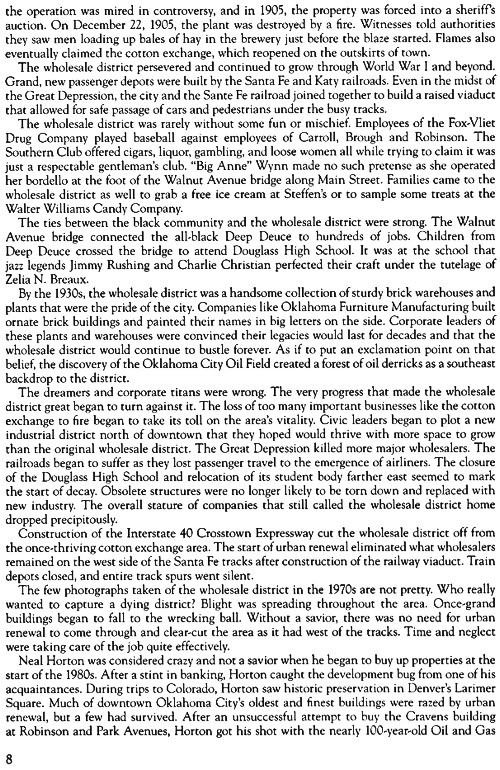
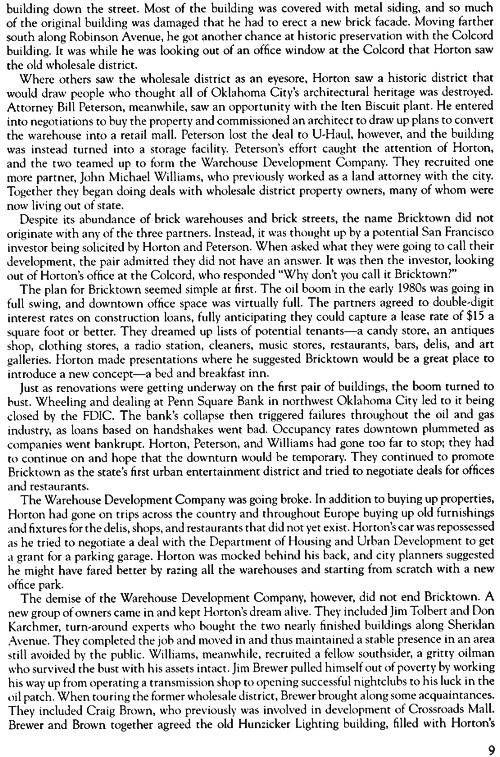
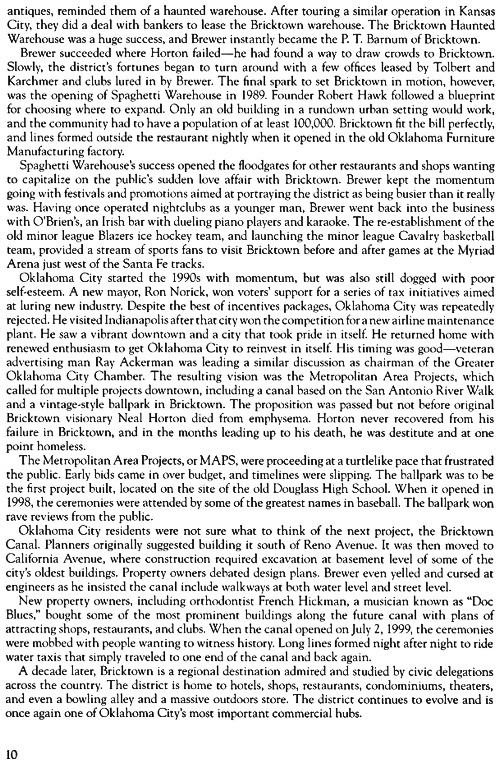
A BAKER'S DOZEN GROUP OF PHOTOS. When I told Steve that my next post would be a review of his book, I said that I'd like to use 6 photos in the book in this article, and he agreed. Moments later, I knew that 6 was not enough and I asked, "Six photos is not enough. I want to use more. Give me a number." He said, "Twelve" and I said, "OK." But, 12 is not enough to capture the essence of the book — so I've recalibrated my thinking and came up with a way to use 14. The image to exclude in the counting process was easy — it's a map which I drew which appears at page 12 of the book. Surely that should not be 1 of the 12. The rest was more difficult since there are so many great images in the book but finally I narrowed it down to 13. A regular dozen is 12 but 13 is a baker's dozen, is it not? So, giving "12" the spin most favorable to what I wanted, I wound up with the "Bakers Dozen" shown in small format in the earlier slide-show.
This shows those images in greater resolution. Click on any image for a larger view.
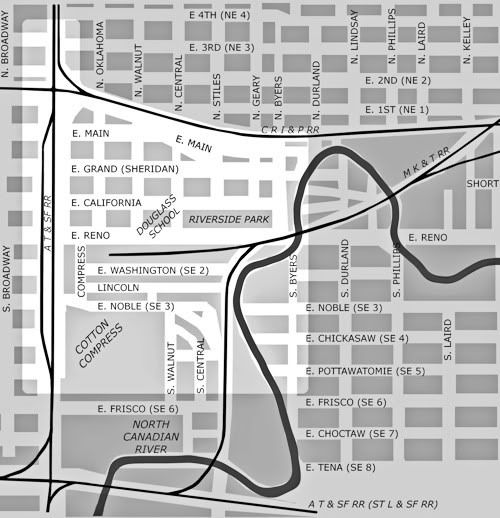
Cotton Compress at page 17, an OKC MLS photo
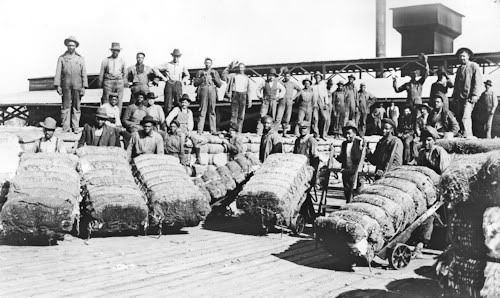
Looking East on Grand (Sheridan) in the 1920s at page 45, courtesy Greater Oklahoma City Chamber of Commerce
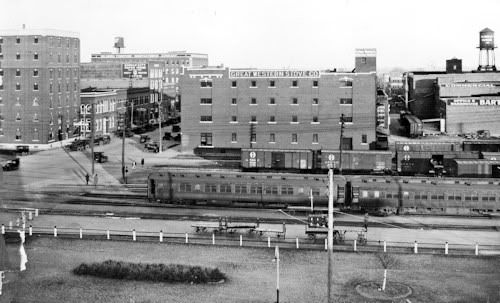
Zelia Breaux at page 49, courtesy Anthony Francisco
She was the Douglass School teacher who taught Jimmy Rushing, Charlie Christian, and Ralph Waldo Ellison
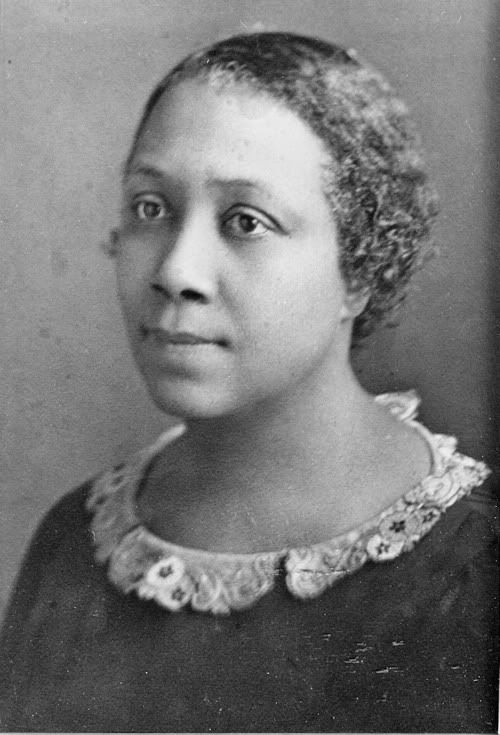
Aerial Photo Probably in the Late 1930s, page 55, Courtesy Greater Oklahoma City Chamber of Commerce

Oklahoma Furniture Manufacturing Company, page 61, Courtesy Greater Oklahoma City Chamber of Commerce, Later to Become The Spaghetti Warehouse
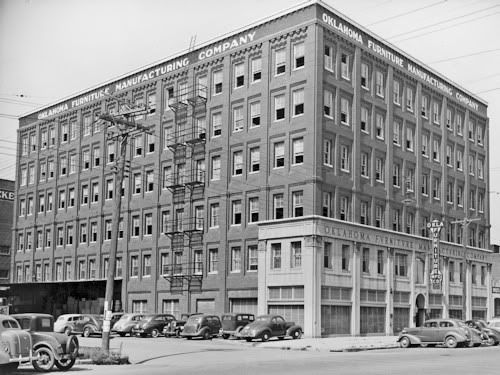
A Rare 1947 Aerial Showing The North Canadian River South of Reno, page 61, Courtesy Greater Oklahoma city Chamber of Commerce
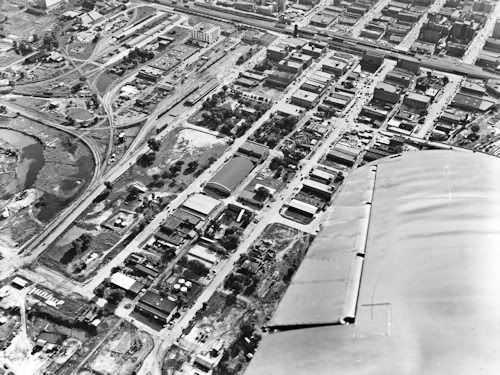
A Cropped View of the Above, Showing the River
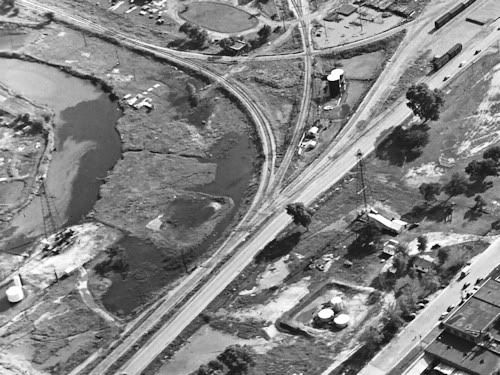
A 2-Page Panorama at pages 70-71 in the Mid-1970s, Courtesy the Greater Oklahoma City Chamber of Commerce
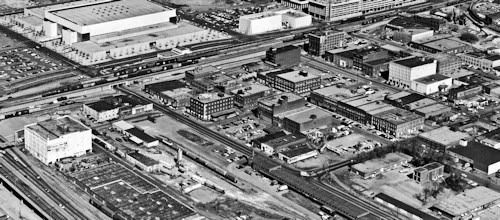
Neal Horton and His Wife, Sue, page 78, Courtesy Virginia Eichor
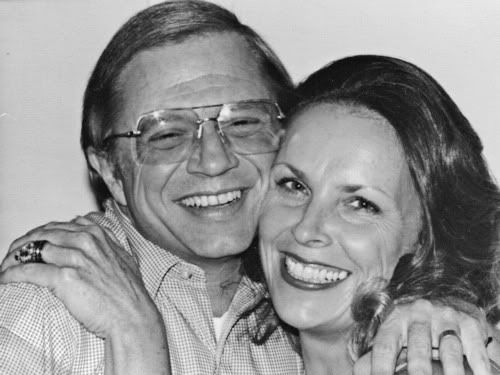
Bricktown Ballpark Around 1998, page 99, Photograph by Bill Moore
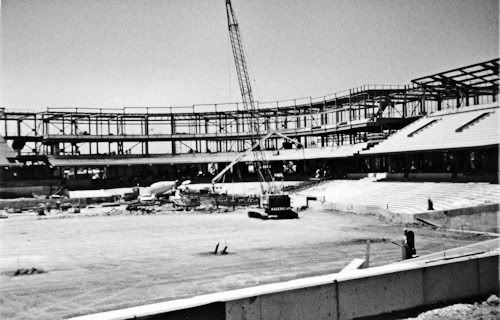
Bricktown Canal Under Construction, page 106, Photograph by Bill Moore

Street Parties in 1998, page 108, Courtesy Jim Cowan
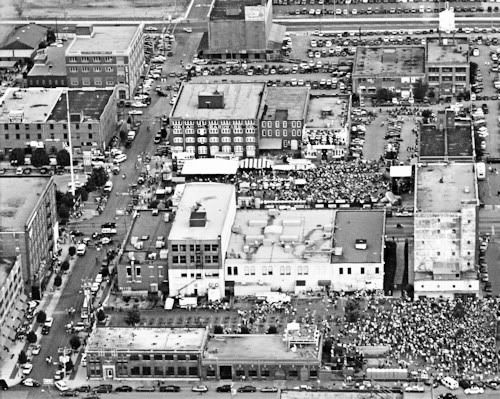
Grand Opening of the Bricktown Canal, July 2, 1999, page 109, Courtesy Bill Moore
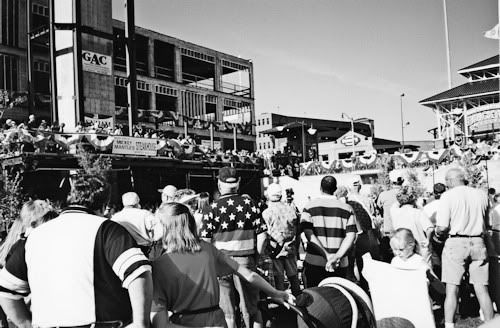
2005 Aerial View Looking Into Lower Bricktown, page 117, Photograph by Michael Downes
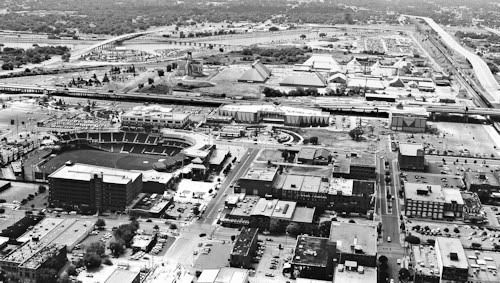
MY OPINION. There are some threshold remarks I want to say before proceeding further.
- First, Steve and I have become good friends and that fact may color my objectivity. Plus, I helped a bit with scanning some of the images to match Arcadia's specifications since I had just gone through that learning curve vis a vis my Springlake book to Arcadia specifications. And, I was privileged to draw a Bricktown map for Steve to use in the book and I considered and consider it an honor to have been able to assist in the production of this book in some small ways.
- Second, About Arcadia's Images of America Series. Arcadia Publishing Company is to be applauded for making available an inexpensive series of quality paperback books about United States cities and places within them through its Image of America series. And, the paper (hence image) quality is very much improved since Griffith's fine 3-part Oklahoma City history was written. Their technical staff does a good job in rendering crisp, not-washed-out, black and white images. In our locale, Arcadia has thus far produced books on Edmond by Jan Mattingly, Terry Griffith's invaluable 3-part series on Oklahoma City history, William Welge's Oklahoma City Rediscovered, the Oklahoma City Zoo by Amy Dee Stephens, Baseball in Oklahoma City by Bob Burke, as well as my own Springlake Amusement Park, and all are worthwhile reading. Arcadia is filling a need.
That said, it must be understood that Arcadia's Images of America series does NOT focus upon the written word, i.e., researched and written text in an academic sense. While Arcadia pays a good bit of attention to photographic quality, it leaves text content up to the authors, and, in my opinion, that is a weakness. Arcadia's Images of America series is written for everyman and everywoman with an emphasis on pictures and not upon a scholastic approach to book-writing. For example, Arcadia allows no footnotes or endnotes and no book index, which is too bad since, those features lacking, some might fault the series out of hand as not presenting serious literature merely because those features are missing — even if the content is researched fastidiously and the text is written in a classy way. I confess that such features are parts of how I evaluate any history book. I want sources I can check out if I want to. I want an index so that I can quickly go to where I want in a book. Stylistically, Arcadia requires its authors to conform to a rote-production-process — each book is limited to 127 pages of material (page 128 is an Arcadia advertisement) including preliminary and other introductory materials; the text-introduction may not exceed 4 pages but is reduced to 3 if an author elects to include a 1-page foreword; each chapter's text introduction may not exceed one page; within chapters, text comments are limited to a given number of characters (varying upon the number of images on the page) which describe the images presented on those pages. These restrictions and limitations were a great concern to me when writing my Springlake book — I had many more words to say and information to pass along, as I'm sure that Steve did — but there is no middle ground. A writer must either conform to Arcadia's approach or else not write the book at all.
Even with these limitations, I found the book to be outstanding. More hard information and certainly more images are included in this 127 page book than you'll find available anywhere else, and it is a definite must-have for anyone interested in Oklahoma City history. Could it be improved in its second printing? Sure — just like my Springlake book could. I'd liked to have had more "date specific" detail presented with some of the images — I always want to know the "when" when reading historical literature. As an example, when did Spaghetti Warehouse plant itself in Bricktown? The date is not presented where the Spaghetti Warehouse photo appears (page 90), even though a forced re-read of the Introduction shows the date - 1989. Why not show that date on page 90, too? As is now obvious, my re-write deals with trifles and not with substance. The book is outstanding. If you have friends or family members who have a care about Oklahoma City history, buy this affordable book for their next present.

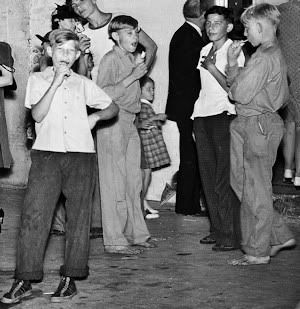













No comments:
Post a Comment